Podcast: Download (Duration: 28:21 — 26.1MB)
Get Notified Of Future Episodes Apple Podcasts | Spotify | Amazon Music | Android | Blubrry | Gaana | TuneIn | Deezer | Anghami | RSS | More
Episode highlights:
02:04 – On stage, about to present…
04:02 – The start of a 14-year career
07:31 – Single-source dependency
09:46 – A job versus a business
11:24 – An introduction to online marketing
13:51 – Hanging out with high achievers
16:35 – The price of the dream
17:41 – Fast forward to today
19:13 – A guess about you
20:24 – The metric that matters
22:14 – Suppose you do THIS…
Grab a copy of James’s book! Click HERE
Transcription:
James Schramko here, welcome to episode 559 of SuperFastBusiness.com.
Today, I’m actually going to be sharing the introduction for my new book, which is called, “Work Less, Make More: The Counter-intuitive Approach to Building a Profitable Business, and a Life You Actually Love.”
I’ve been working on this book for quite some time, so I’m pretty excited that it’s about to be launched. So I hope you enjoy the introduction. I thought it would be a great way to get a feel for what’s coming.
In the following episode after this, I’m going behind the scenes with a lady who really helped me a lot putting the book together, her name’s Kelly Exeter, and you’ll be discovering the process we went through to get to this stage and some of the challenges and some of the ideas. So hopefully, the introduction again will give you enough context to add some value to that conversation.
So let’s get on with it.
By the way, if you want to know when the book’s out, please go to SuperFastBusiness.com/book. Or if you’re listening to this introduction some time after it was recorded and the book sounds like something you’re interested in, please go to SuperFastBusiness.com/book and you’ll get the details of how you can access Work Less, Make More.
Are You Leaving Life On the Table?
I’m on stage, about to present at a very exclusive conference. There are 50 people sitting in front of me, and they all share a few traits.
They’re smart and highly driven.
They’ve paid thousands of dollars to be here (and so understand the value of investing in themselves and their businesses).
And … they’re tired.
Some of them are making decent money, but they’re working really hard for it.
As I start to speak, I can see them looking at me thinking I’m going to be yet another guy telling them all the things they can do to make more money. Things that will involve them working even harder than they are now.
Then I share with them what my average working day looks like:
I wake up, drink a glass of water, check the surf conditions, have some breakfast, make a coffee, go for a surf, come back home and only then do I sit down at my computer for a few hours and do my highest-level activity. I then have a leisurely lunch, go for another surf, do another focused block of activity, shift my attention to dinner and entertainment, and then it’s off to bed.
Yes, that’s right. I work just a few hours a day.
At this point I have the room’s undivided attention. I’m not the first guy to talk about working less. But I am the first guy they’ve come across who’s actually doing it while making six figures a month. (Yep, a month.)
No hustle.
No weekly selling webinars or online summits.
No stress-inducing, sleep-depriving, relationship-threatening once-a-quarter product launches.
Just a business model with smooth cash flow, predictable income, and the ability to do work that is meaningful to me.
Of course, life didn’t always look like this.
Working for the man
In 1994, I was 23, newly married and working a desk job in a telecommunications company.
A workmate of mine was occupying our spare room at the time, and his average working day looked like this: sleep in every morning, jog down to the beach for a swim, come back, make some phone calls for a bit, then go out with his friends and drink.
He was in sales, making six figures a year.
I was the guy in the office doing all the work, processing his orders and taking home the handsome sum of $35,000.
My wife, on a similar salary, was pregnant. And we were in a bind. We couldn’t afford to live on my wage alone when the baby arrived. I needed to double my income—fast. And it was clear the only way to do that was to move into sales.
Unfortunately, the company I worked for liked me right where I was—performing a complex role that would be difficult to train someone else to do.
I had to look elsewhere.
Having been passionate about cars my whole life, I headed for the car yards. After being rejected by a Toyota dealership, my next port of call was BMW. And after some persuasive talking, I beat 27 applicants for the job, securing my chance to make some tidy commission on top of a very low base salary.
This was the start of a 14-year career in the car industry.
I was good at selling cars.
By the age of 24 I was the number one BMW salesperson in Australia.
By the age of 27 I was working for Mercedes-Benz, and had been in the new car sales guild for high achievers twice. (My second year there, I was number one in Australia.) I was a sales manager at 28, general sales manager at 30, and general manager of an entire dealership by 33.
What set me apart from my peers?
The first thing was that I read business books voraciously.
I first picked up Tom Hopkins’ How to Master the Art of Selling when I was 12. In my 20s I was on to Jay Abraham, Peter Drucker, Dan Kennedy and Gary Halbert, consuming everything they had to offer about growth strategies for business.
The second thing was that I actually put those learnings into action.
I measured everything, creating systems and processes that went with me from dealership to dealership. These allowed me to not only achieve personal success, but also turn around underperforming dealerships and make them highly profitable. My sales processes were so good Mercedes-Benz asked me to train sales managers from other dealerships in advertising for, hiring and training new salespeople.
The third thing was that I was very motivated.
At 31 I was a father of four, and we were servicing two mortgages while living in one of the most expensive cities in the world—Sydney. My number one priority at the time was to provide my family with a comfortable life free from financial stress. Having worked my way up to a salary package of around $300,000 a year at this point, you’d think I’d be saying I achieved that goal.
The truth was, I felt a long way from being financially safe.
The perils of single source dependency
I had a privileged upbringing thanks to my father having a very senior role in the company he worked for. My family lived in the expensive Sydney suburb of Mosman, and I went to an exclusive private boys’ school.
While I was at school, the 1980s happened—massive inflation, and interest rates through the roof. But my dad was making great money. My family was fine.
Until the 90s that is, when a corporate raider bought the company my father worked for, promptly liquidated the assets and made my dad redundant.
My dad’s salary couldn’t be replaced in the harsh economic climate of the time. Which meant my parents were completely crunched—caught with high interest rates on a big mortgage, a luxury car lease, and a small amount of equity in their home.
This was my first exposure to the perils of single-source dependency.
“Having all your income coming from one source is a huge risk.”
While it was the way most people did things back then, having all your income coming from one source, (i.e. a job) is a huge risk.
My parents had to sell the expensive house and car and rebuild their assets from scratch. They did it, but it took decades and incredible resilience on their part.
Fast forward to 2007, and I find myself in a similar situation.
I’m sitting in the lunchroom at work, reading about the problems America is having with the sub-prime lending market and thinking, If this spreads to Australia and people stop buying luxury cars, I’m not going to fare well.
I’d negotiated my way to a salary very few dealerships could afford to pay. My family’s assets and way of life were completely dependent on that income. Most interestingly, all the systems and processes I’d laid down at my dealership meant it operated like clockwork and could realistically run without me.
If the bottom fell out of the Australian market, I was going to find myself in the same position my dad did all those years ago. The thought of walking into my house one day and explaining to my family that I had no income was haunting.
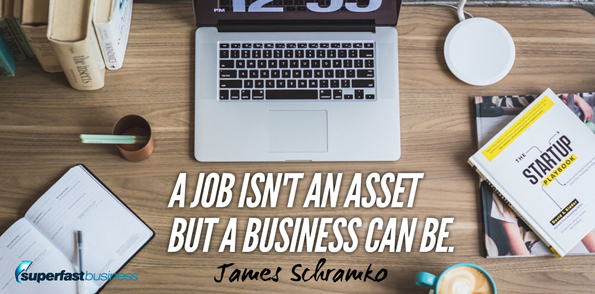 A job isn’t an asset. But a business can be.
A job isn’t an asset. But a business can be.
In September 2006 I wrote this in a notebook:
MY GOALS … create automated income so I am independently wealthy and can enjoy my life passionately.
One thing that had become abundantly clear well before the financial meltdown: a job, no matter how well it paid, could not provide me with:
• Automated income
• Independent wealth
• The ability to enjoy my life passionately
The business books I’d read throughout my 20s also highlighted that having a business was the best way to build an asset.
Time invested in a job was compensated via a capped wage. No matter how hard you worked, the amount you would make would always have a ceiling on it.
But there was no limit to what you could make from a business. All the rewards of hard work went into your pocket, not someone else’s. And a business set up correctly was an asset that could be sold.
For these reasons, I always had some kind of side-business going alongside my jobs in the car industry.
I bought and sold custom number plates with a workmate for a while.
I started an advertising company with an accounting college friend, where we tried to sell premium space in the supermarket to American Express.
I wrote sales copy for a building company to run as newspaper advertisements.
I helped my acting school coach build his school up from ‘mired in credit card debt’ to a booming, profitable success.
I did several sales training sessions for a financial planner, which I reinvested into buying a new laptop for home.
Somewhere along the way I realised if I was ever going to achieve a level of financial independence where my family never had to worry about money again, I needed to have a business where I was both creating value for thousands of people and getting paid by thousands of people. That way, if one person was upset and decided they weren’t going to pay, no dramas—my income was not entirely dependent on them.
The internet seemed to be the way to achieve this.
Customers were arriving at the showroom knowing more about the new models than Mercedes-Benz were telling us. The travel industry had been revolutionised, and customers were making their own bookings instead of going into a travel agency. I was buying CDs on the internet instead of going to a store.
While searching for a Jay Abraham book one day, I found a page that was very compelling. In amongst the bold, italicised and highlighted words, it offered some Jay Abraham reports for free. Once I downloaded those reports, they said I could help other people get them. And if these people happened to buy something, I would earn a commission.
This seemed very exciting.
It was my first attempt at affiliate marketing, which is essentially being a commission-only sales person for an online business. I thought to myself, This will be just like selling cars, except I can make sales to hundreds of people at any time of the day or night—even when I’m asleep.
So, I rolled out my ten feet of internet cable to the phone line, plugged in my laptop and got to work. Over the coming weeks I:
• grabbed my special affiliate link from ClickBank
• built myself a landing page using the free page my internet service provider gave me (it was black with green text)
• put a whole bunch of links to Jay Abraham stuff on there.
Then I sat back and started dreaming about what I’d do with all the money that was about to come gushing into my account.
Except I sold zero.
Not a thing.
I had a lot to learn, and learn I did.
Over the next six years I learned about:
• building websites
• direct response marketing, split testing, writing ad copy and creating e-books
• using Google to place advertisements (AdWords) that would send me customers, and getting Google to rank my website at the top so people would click on my website (SEO).
But perhaps the most important thing I learned was how crucial it was to make the right kind of friends.
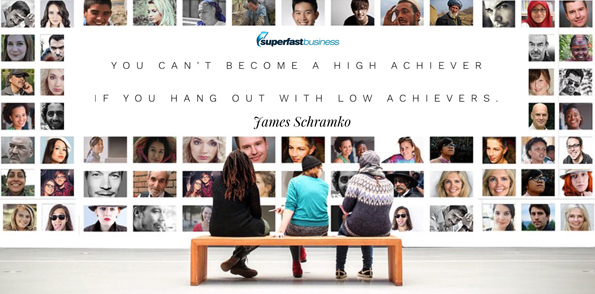 You can’t become a high achiever if you hang out with low achievers
You can’t become a high achiever if you hang out with low achievers
When I’d just started out in car sales, I was always the first guy at the dealership in the morning. I’d often be sitting there reading my Tom Hopkins How to Master the Art of Selling book when the other sales guys came in.
‘What are you reading that sh*t for?’ they’d ask.
(They got their answer a year later when I was outselling not only them, but every BMW salesperson in Australia.)
In those early days, books were my way of hanging out with high achievers. When I entered the online world, I continued to learn from the best. I read everything I could get my hands on from the experts at the time—Rich Schefren, Yanik Silver, Perry Marshall, Dan Kennedy, Stephen Pierce, John Carlton, Joe Sugarman, Gary Halbert, Jonathan Mizel, John Reese and others.
The best thing about all these people was that many of them ran events. I got to meet several of them in real life, and some became friends. Not only that, some of the ‘regular’ people I was meeting and becoming friends with at these events were doing pretty huge things.
One guy was making $100,000 a month as a super-affiliate for a range of products. He’d run ten affiliate campaigns at a time, and inevitably one of them would work really well. Then he’d run another ten. And another ten. He’d keep the campaigns that worked well, and turn off the ones that didn’t. It was a simple yet effective approach without too much tech.
By this stage I was achieving some success in the online world. I was an affiliate for XSitePro (Windows-based software for building websites), and throughout 2006 and 2007 my commissions started to build: from $250/month to $750/month to $1,000/month to $5,000/month.
Then I created an XSitePro cheat sheet. I launched it for $67 and it made $7,000 in the first week.
That’s $1,000/day—the same amount my job was making me.
My thought at the time was, If I can keep this up, I could quit my job.
“High achievers force you to think bigger.”
The benefits of hanging out with high achievers? They force you to think bigger. They raise the benchmark for what’s possible.
Tim, the guy who was earning $100,000 a month, asked me why I was underselling myself.
‘Dude, seriously. You’re only making $300,000 in a whole year? I make that in less than three months!’
The message was clear. ‘If I can do it, you can too.’
I quit my job in 2008
Tim was right. Forget six figures a year. I could make six figures a month, and I went on to do just that.
I’m still doing so today.
But I did it the hard way. (Harder than you’ll have to because you have this book.)
In those final years of my life as an employee I was working two shifts—the 8am-7pm shift at the dealership, and then a 9:30pm-3am shift at home. I was pushing hard to make enough money from my online ventures so I could quit the dealership.
As you could imagine, there was no ‘living’ going on there. I was overweight, pale, stressed, tired and permanently cranky. Some people around me told me I was going to kill myself from exhaustion.
When I quit my job, I was still working like crazy in pursuit of those three key elements from the 2006 notebook:
• Automated income
• Independent wealth
• The ability to enjoy my life passionately
It seemed like I crammed 20 business years into the first five years that followed my dealership days.
But, as you know, I got there in the end. I arrived at the business model I mentioned earlier—the one with smooth cash flow, predictable income and the ability to do work that’s meaningful to me without being a workaholic.
A large part of that meaningful work is coaching, and over the past nine years I’ve worked directly with more than 4,000 business owners (and indirectly with several hundred thousand via my podcasts). It’s been incredibly fulfilling to help them:
• get where they want to faster than I did
• avoid the pitfalls I learned about the hard way.
• keep their eye on the prize and avoid distractions.
It’s also been nice to be an example of how making good money doesn’t have to involve 60-hour work weeks.
Some of my students are posting staggering numbers today, and this makes me happy. Not just because they’re ‘rich’, but because money gives them freedom:
• from doing things they don’t really like doing. (They can now hire people to do those things, both in their business and their homes.)
• from stress, because there’s no single source dependency in their lives. (It’s okay if one income stream ceases to exist because they have others.)
• to take on passion projects that make no money at all.
Most of my students are still on an upward journey, of course. But they’re making enough money to live well, reduce their debt significantly, and create financial buffers that protect them from disasters. And they no longer work nights and weekends, which means they have time to:
• look after their health
• hang out with the people they love
• pursue the things that interest them.
They’re not leaving life on the table anymore.
Three things I’m guessing about you
First, you’re probably working hard for your money.
I can say this with a fair degree of certainty because it’s been true for every person I’ve ever coached. And chances are you wouldn’t be reading this book if you spend your days lying on a beach in the Bahamas, living comfortably off a trust fund.
Second, you’re miles ahead of where I was when I first started seeking financial independence.
The level of information you can access for free and the tools you have at your disposal today are second to none. (You’re definitely not trying to hand-code a website in HTML like I was in 2005.)
Third, you’re probably overwhelmed.
All that information is as much a curse as it is a blessing. There are thousands of tools out there that might just be the ‘game changer’ you’ve been waiting for. There are thousands of ‘gurus’ with ‘proven systems’ and rock-bottom stories offering ‘shortcuts to success’. Every life on social media is so airbrushed it’s impossible to tell who’s full of sh*t and who isn’t.
“Is there just one thing you can focus on that will help you get your life back?”
So, how can I help you? After all, your time and energy are limited. Is there just one thing you can focus on that will help you get your life back?
I think there is.
The metric that matters
To work less and make more, all you need to do is move the needle on one
metric: Effective Hourly Rate (EHR).
Here’s how to calculate your EHR:
1. Take the amount of revenue you make in a month and subtract your costs. What you have left is your monthly profit. (If you have a job, then your wage is your profit.)
2. Divide your profit by the number of hours you worked in the month to get it.
The number you have is your EHR.
Let’s say you make $20,000 a month in revenue, and your fixed and variable costs come down to $15,000. That means your profit will be $5,000. If you work 250 hours a month to achieve that profit then your Effective Hourly Rate is $20/hour.
Have you checked your EHR yet? If you haven’t, now is a good time to calculate it. Make a note of it, along with today’s date, because we’re about to make some changes.
If your EHR is around $20/hour like this example, don’t stress. I’ve seen that number many times before. And I’m sure I’ll keep seeing it, given how many entrepreneurial types discover they have an EHR of less than $10/hour.
So, the ‘average’ work week is considered to be around 40 hours, (roughly 173 hours per month). We know many people work a lot more than that. Some entrepreneurs brag about working more than 300 hours a month.
Now consider this: If you’re working 60 hours a week and have a family or a partner, they won’t see much of you because you’re working nights and weekends. You probably don’t have the time to exercise or eat properly either, so your health may also be suffering.
Furthermore, an EHR in the range of $20/hour means you’ll always be struggling to achieve financial independence—the mental freedom that comes from never having to worry about money.
Here’s where I’m going to suggest something quite counter-intuitive.
I’m going to ask you to immediately reduce your work hours (gasp).
Why? Because it’s very hard to find the energy and the mental space you need to increase your revenue if you’re working long hours day in and day out. And if you can’t increase your profit, you can’t increase your EHR.
Right now, working fewer hours might seem impossible. That’s okay. This book will show you how eliminating certain activities while building your health will ensure your life becomes both easier and more profitable.
Now, back to that first EHR calculation we did.
Let’s say that after reading just a fraction of this book you manage to increase your monthly revenue to $25,000 a month while keeping your fixed and variable costs the same at $15,000. Your profit is now $10,000. And if you focus only on the things that matter and generate profit, and drop anything that doesn’t, you should be able to reduce your work hours from 250/month to 160/month.
$10,000/160 = EHR $62.50/hour
You’re now making three times more per hour working 90 hours less per month!
And you are on your way.
When you’re only working 160 hours a month, you’ll be amazed at how much energy you have and how clear your thinking becomes. From there, it’s not a huge jump to build your monthly revenue to $40,000 while your fixed and variable costs rise slightly to $20,000. (The extra costs will likely be a mix of hiring a team or buying more marketing.) Your profit will become $20,000.
Let’s say you now reduce your working hours a little more, because you have better systems in place and are enjoying life more. Now you’re working 130 hours a month (roughly six hours a day, five days a week; or five hours a day, six days a week).
$20,000/130 = EHR $154/hour
This is where life starts getting really great. You’re making more money, working fewer hours, seeing more of your family, and you even have time for a fun hobby. (Remember fun? Remember hobbies?)
You’re also sleeping better, which translates to a clearer head and better productivity when you’re working.
Now, let’s take your clearer head and improved energy levels (along with this book), and channel them into creating a product or service that generates $100,000 per month.
The key figures will now look something like this:
• $100,000 a month in revenue
• fixed and variable costs of around $40,000
• profit of $60,000
By now you’ll only be working 100 hours a month because you have a great team and great systems in place.
$60,000/100 = EHR $600/hour
If an EHR of $600/hour or more seems unbelievable to you right now, that’s okay. I never thought I’d be seeing numbers like that either. But it’s actually typical of what many of my students have been able to achieve. And it’s certainly how I live my life now.
Best of all, we get to choose our work hours. We can work 7-8 hour days, three days a week. Or 4-5 hour days, five days a week. Because we can choose our work hours, we can choose to work when our energy levels are the highest. Which means when we’re on, we’re on. And when we’re off, we get to actually relax and enjoy life.
Increasing your EHR to this level is a learnable and repeatable process. If you read this book and take action along the way, I promise you will experience some powerful EHR transformations.
Is EHR the only metric when it comes to running a profitable business that lets you live a life you actually love?
No, it’s not.
But it is the most useful metric in the context of how to measure change as a result of reading this book.
My promise to you
I could tell you how I’ve helped clients become multi-millionaires, put together incredibly lucrative triangulation deals and brokered some great joint ventures.
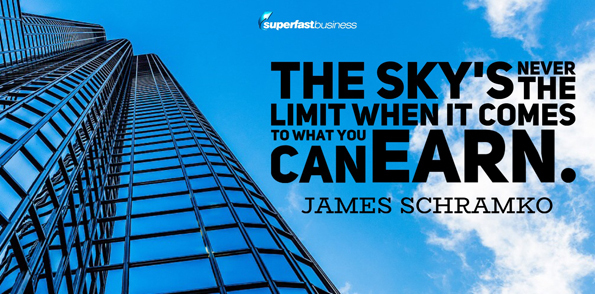 I could tell you about the high-flyers I’m now friends with, and how ‘the sky’s never the limit’ when it comes to what you can earn.
I could tell you about the high-flyers I’m now friends with, and how ‘the sky’s never the limit’ when it comes to what you can earn.
I could make some huge promises based on what I’ve helped other people achieve.
But I don’t want this book to be such aspirational fluff that gets you thinking, ‘One day I’ll be able to …’
I want you to take action at the end of every chapter.
With that in mind, let me give you two examples of just how easy it is to positively impact your EHR.
ONE: You’re probably doing something in your business right now that’s taking up a fair amount of your time, yet you’re struggling to see the benefits. (I can almost guarantee it involves a prominent social media platform.) But you keep doing it either because other people said you should, or because ‘everyone else is doing it’, or you never thought about why you should do it at all.
Stop doing that thing right now. (Or at least limit it to one hour per day.)
Result: Not only has your EHR just increased, you’ll also feel relief at not having to persist with it any longer.
Perhaps you have ‘that client’ or ‘that product’ or ‘that project’. Someone or something tedious that consumes far more resources than you get in return for your effort.
Drop it.
Result: Now you have more time for the great clients/products/projects.
Do these two things sound too easy?
I’m only just getting started!
Head over to Chapter 1. It’s time to ramp up your personal effectiveness.
I hope you enjoyed the introduction here. I’m James Schramko, and this is the book Work Less Make More. You can get more details about this book at SuperFastBusiness.com/book. I really hope you get a copy of it because there’s a whole bunch of fantastic information that comes after the introduction, and I know it’s going to have a profound impact on your life. Thank you so much for listening.
By the way, if you’ve got any comments or you care to review the book on Amazon when it comes out, I’d be truly grateful.
Liked this episode? Get more of the podcast on iTunes
Order the book HERE
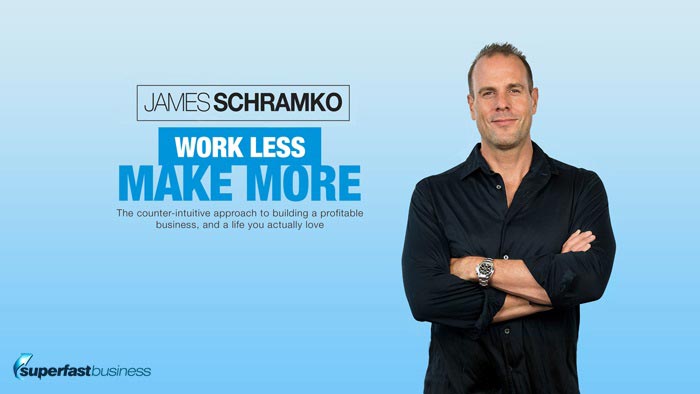
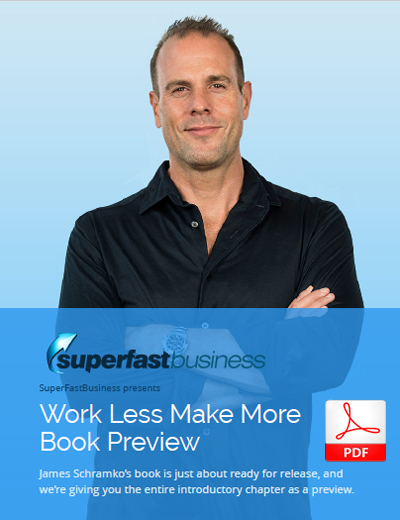


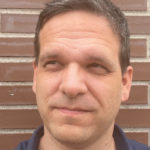
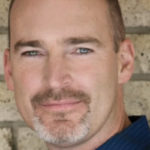





Great preview (and teaser) ;)
Looking forward to the release!
Great preview (and teaser) ;)
Looking forward to the release!
Thank you !
Great listen – looking forward to reading the book over xmas
Thank you !
Great listen – looking forward to reading the book over xmas
Thank you !